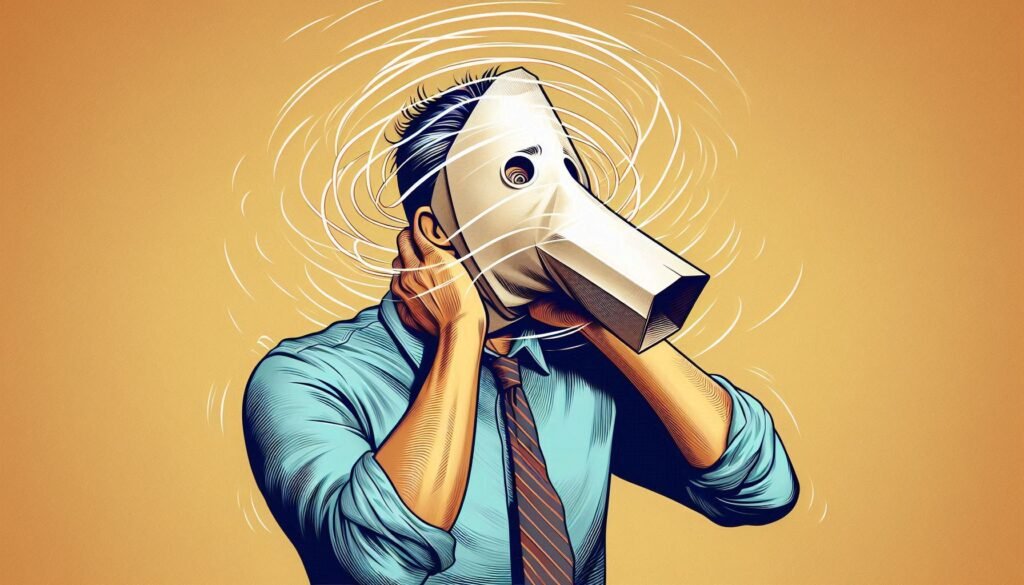Have you ever felt like your breath is racing, leaving you lightheaded and overwhelmed? You’re not alone. Hyperventilation affects countless individuals, often manifesting during moments of extreme stress or anxiety. While many might dismiss it as just rapid breathing, hyperventilation is a complex physiological response that can have far-reaching effects on both the mind and body.
Understanding hyperventilation goes beyond simply recognizing its symptoms; it’s about delving into the triggers and implications associated with this condition. Whether it strikes during an intense panic attack or creeps up in seemingly calm situations, grasping the mechanics behind excessive ventilation can empower us to manage our breathing effectively. Join us on this journey as we explore everything from common triggers to effective treatment strategies for hyperventilation. Your path to calmer breaths starts here!

Defining Hyperventilation: More Than Just Rapid Breathing
Hyperventilation is often misunderstood as merely breathing too quickly. While rapid breaths are a hallmark symptom, the condition involves a significant imbalance in carbon dioxide and oxygen levels in the blood.
“How Does Interstitial Lung Disease Progress? Complete Guide”
When someone hyperventilates, they expel more carbon dioxide than their body can replace. This disruption can trigger various physiological responses, leading to sensations of dizziness, tingling in extremities, or even chest discomfort.
It’s essential to recognize that hyperventilation isn’t just an isolated event; it may indicate underlying anxiety or stress disorders. Sometimes it occurs during physical exertion or specific medical conditions.
Understanding this nuanced definition helps demystify why some people experience persistent episodes. It highlights the importance of addressing both emotional and physical aspects when dealing with hyperventilation effectively.
The Physiology of Breathing: Understanding Normal vs Excessive Ventilation
Breathing is a vital process that supplies oxygen to the body and removes carbon dioxide. Normal ventilation occurs at a steady pace, typically 12 to 20 breaths per minute for adults. Each breath involves an intricate interplay between the diaphragm and intercostal muscles, ensuring efficient gas exchange.
Excessive ventilation, on the other hand, disrupts this balance. When someone hyperventilates, they take rapid and shallow breaths. This can lead to decreased levels of carbon dioxide in the blood—a condition known as hypocapnia.
“What’s the Difference Between Acute and Chronic Bronchitis?”
Hypocapnia alters blood pH levels and may result in symptoms like dizziness or tingling sensations. Understanding these physiological differences is crucial for identifying when breathing becomes problematic rather than merely fast. Recognizing how our bodies respond under stress helps in managing conditions related to hyperventilation effectively.
Common Triggers of Hyperventilation: From Anxiety to Medical Conditions
Hyperventilation can stem from various triggers that affect individuals differently.
Anxiety is one of the most common causes. When stress levels spike, breathing patterns often change dramatically. This rapid shift can result in an increased respiratory rate, leading to hyperventilation.
Physical exertion is another trigger. Intense exercise or strenuous activity may cause some people to over-breathe as their bodies demand more oxygen.
“How Does Pericarditis Affect Your Breathing? Key Information”
Medical conditions also play a role. Respiratory disorders like asthma or chronic obstructive pulmonary disease (COPD) can lead to episodes of hyperventilation due to difficulty catching one’s breath.
Additionally, hormonal changes during pregnancy or menstruation might contribute. These fluctuations can impact respiration and sometimes trigger hyperventilatory responses.
“Can Kyphoscoliosis Cause Breathing Problems? Expert Guide”
Environmental factors such as high altitudes or poor air quality may exacerbate existing issues and provoke hyperventilation symptoms in sensitive individuals.
Recognizing Hyperventilation Syndrome: Key Symptoms and Signs
Hyperventilation syndrome can manifest in various ways. Recognizing its symptoms is crucial for effective management.
One of the most common signs is rapid breathing. Individuals may notice they are taking shallow, quick breaths rather than deep and slow inhalations.
Dizziness often accompanies these changes in breathing patterns. This sensation can feel quite unsettling and may lead to feelings of lightheadedness.
“What is Guillain-Barré’s Impact on Breathing? Critical Information”
Many people report tingling sensations, particularly around the hands and face. This occurs due to fluctuations in carbon dioxide levels in the blood.
Increased heart rate or palpitations may also be present, contributing to a sense of anxiety. Some individuals might experience chest tightness as well.
Emotional responses play a significant role too; irritability or panic attacks can arise unexpectedly during episodes of hyperventilation. Awareness of these key symptoms aids early intervention and support.
The Vicious Cycle: How Anxiety Perpetuates Hyperventilation
Anxiety and hyperventilation are closely linked in a challenging cycle. When a person experiences anxiety, the body enters a state of heightened alertness. This triggers rapid breathing, often leading to hyperventilation.
“Why Can’t I Breathe Lying Down? Understanding Orthopnea”
As breathing becomes faster and shallower, carbon dioxide levels drop. This can cause symptoms like dizziness or tingling sensations, which may amplify anxiety further. The individual then starts to focus on these discomforting feelings.
This increased awareness creates more panic. Before long, they find themselves trapped in a loop where anxiety fuels hyperventilation, and hyperventilation exacerbates anxiety.
Recognizing this cycle is crucial for effective management. Understanding that one’s breath influences emotional states can empower individuals to break free from this pattern and regain control over their bodies during moments of distress.
Diagnostic Approaches: Ruling Out Other Medical Conditions
When dealing with hyperventilation, it’s essential to differentiate it from other medical conditions. Various health issues can mimic its symptoms, leading to potential misdiagnosis.
Healthcare providers often start by taking a thorough patient history. This includes discussing recent stressors, physical activities, and any underlying health concerns. Understanding the context of the symptoms is key.
“What Causes Trepopnea? Position-Related Breathing Problems”
Next, clinicians may conduct a physical examination to assess respiratory function and overall health status. They might listen for abnormal lung sounds or check for signs of respiratory distress.
Diagnostic tests like blood gas analysis are also common. These tests measure oxygen and carbon dioxide levels in the blood, providing insight into how well your body is ventilating.
In some cases, imaging studies such as chest X-rays or CT scans may be necessary to rule out conditions like pneumonia or pulmonary embolism that could cause similar breathing difficulties.
The Impact of Chronic Hyperventilation on Body Systems
Chronic hyperventilation can have far-reaching effects on various body systems. When breathing becomes excessive, it alters the balance of oxygen and carbon dioxide in the bloodstream. This imbalance can lead to tingling sensations, lightheadedness, and even muscle cramps.
The cardiovascular system also feels the strain. Hyperventilation may cause an increase in heart rate and blood pressure, putting additional stress on the heart over time.
“How Does Hypercapnia Affect Your Body? CO2 Buildup Guide”
Moreover, persistent rapid breathing can affect digestive health. It may lead to symptoms like bloating or gastrointestinal discomfort due to reduced blood flow to the stomach.
Additionally, chronic hyperventilation is linked with fatigue and sleep disturbances as restless nights become common when anxiety-driven breathing patterns persist. The interplay between these systems highlights how essential balanced breathing is for overall well-being.
Treatment Strategies: Addressing Both Physical and Psychological Factors
Effective treatment strategies for hyperventilation often require a dual approach, addressing both physical and psychological factors. On the physical side, clinicians may recommend breathing retraining exercises. Techniques such as diaphragmatic breathing can help restore normal ventilation patterns.
Psychological aspects are equally crucial. Cognitive Behavioral Therapy (CBT) is particularly beneficial in managing anxiety that triggers hyperventilation episodes. By changing negative thought patterns, individuals can learn to cope better during stressful situations.
Additionally, incorporating mindfulness practices like meditation and yoga can significantly decrease stress levels. These methods promote relaxation and enhance body awareness.
Education about hyperventilation also plays a vital role in treatment. Understanding what happens during episodes empowers patients to manage their symptoms more effectively without fear or confusion. Together, these strategies create a comprehensive plan tailored to individual needs, fostering both emotional resilience and physiological stability.
Breathing Techniques to Control Hyperventilation
Breathing techniques are essential for managing hyperventilation. By focusing on how you breathe, you can regain control and calm your body.
One effective method is diaphragmatic breathing. This technique involves engaging your diaphragm instead of shallow chest breathing. To practice, lie down or sit comfortably. Place one hand on your chest and the other on your abdomen. Inhale slowly through your nose, allowing your stomach to rise while keeping the chest still.
Another useful approach is the 4-7-8 technique. Inhale quietly through your nose for four seconds, hold that breath for seven seconds, then exhale completely through pursed lips over eight seconds. This rhythm helps slow down the heart rate and promotes relaxation.
Pursed-lip breathing can also be beneficial during episodes of hyperventilation. Inhale deeply through your nose and exhale slowly through pursed lips as if blowing out a candle. This creates resistance in the airways and helps regulate airflow effectively.
Practicing these techniques regularly can empower individuals to manage their symptoms more confidently.
Cognitive Behavioral Therapy: Retraining the Mind and Body
Cognitive Behavioral Therapy (CBT) is a powerful tool for managing hyperventilation. It focuses on the connection between thoughts, feelings, and behaviors.
Through CBT, individuals learn to identify and challenge irrational beliefs that contribute to anxiety. This process helps break the cycle of panic that often leads to rapid breathing episodes.
Therapists guide patients in developing coping strategies. These may include reframing negative thoughts or practicing mindfulness techniques. As individuals retrain their minds, they can also calm their bodies.
Regular practice enhances emotional resilience and promotes healthier responses to stressors. By addressing both cognitive patterns and physical reactions, CBT fosters a comprehensive approach to managing hyperventilation effectively.
This therapy empowers people with tools to navigate challenging situations without succumbing to overwhelming fear or breathlessness. The integration of mind and body awareness is key in achieving lasting change for those affected by this condition.
Medications: When Pharmacological Intervention Is Necessary
Medications can play a critical role for individuals experiencing hyperventilation, especially when symptoms are severe or persistent. In such cases, pharmacological intervention may be necessary to stabilize breathing patterns and alleviate anxiety.
Commonly prescribed medications include selective serotonin reuptake inhibitors (SSRIs) and benzodiazepines. SSRIs help manage underlying anxiety disorders that often accompany hyperventilation. Benzodiazepines provide quick relief during acute episodes but should be used cautiously due to the potential for dependence.
For some patients, beta-blockers may also be beneficial in controlling physical symptoms like rapid heartbeat associated with anxiety-induced hyperventilation. These medications address specific physiological responses while allowing other therapies to take effect.
Consultation with a healthcare professional is essential before starting any medication regimen. A tailored approach ensures that treatment addresses both the psychological and physiological aspects of hyperventilation effectively.
Lifestyle Modifications to Reduce Hyperventilation Episodes
Making lifestyle modifications can significantly reduce hyperventilation episodes. Simple changes in daily habits often yield noticeable improvements.
Regular exercise is one of the best strategies. Engaging in physical activities like walking, yoga, or swimming helps regulate breathing patterns and reduces stress levels over time.
Mindfulness practices are also beneficial. Techniques such as meditation and deep-breathing exercises promote relaxation and enhance awareness of your body’s signals.
Staying hydrated is crucial for overall health. Dehydration can exacerbate symptoms of anxiety, which may lead to increased hyperventilation episodes.
Limiting caffeine intake can make a difference too. Caffeine stimulates the nervous system and may heighten feelings of anxiety, triggering rapid breathing responses.
Establishing a consistent sleep schedule plays a vital role in managing stress levels. Quality rest allows the body to recover and better cope with potential triggers throughout the day.
Consider keeping a journal to track any patterns or triggers related to your hyperventilation episodes. This insight can help you create more effective coping strategies tailored just for you.
The Link Between Hyperventilation and Panic Disorders
Hyperventilation often coexists with panic disorders, creating a challenging cycle for those affected. When anxiety levels rise, rapid breathing can trigger sensations like dizziness and chest tightness. These symptoms mirror those of a panic attack.
Individuals experiencing panic attacks frequently hyperventilate as their bodies react to perceived threats. This over-breathing reduces carbon dioxide levels in the blood, leading to further distressing physical reactions. As this pattern continues, fear of future attacks may intensify.
Managing hyperventilation is crucial for individuals dealing with panic disorders. Addressing both conditions simultaneously helps break the loop where anxiety fuels breathlessness and vice versa. Through targeted strategies such as cognitive behavioral therapy or relaxation techniques, it is possible to regain control over breathing patterns and reduce overall anxiety levels effectively. Understanding this connection allows for more effective treatment plans tailored to individual needs.
Occupational Considerations: Jobs That May Trigger Hyperventilation
Certain occupations can heighten the risk of hyperventilation. Jobs that involve high stress or intense focus often trigger rapid breathing episodes.
Healthcare workers frequently face fast-paced environments. Long hours and critical situations can lead to anxiety, causing hyperventilation.
Similarly, first responders deal with life-and-death scenarios regularly. The pressure to perform under stress makes these professionals particularly susceptible.
Creative fields, such as performing arts, may also contribute to this condition. Anxiety before performances can result in excessive ventilation as individuals try to cope with nerves.
Even jobs requiring prolonged periods of concentration—like programming or data analysis—can lead to shallow breathing patterns over time. A lack of awareness about one’s breath while engrossed in work might foster a cycle of tension and distress.
It’s crucial for those in high-pressure roles to recognize their breathing patterns and seek strategies for management when necessary.
Hyperventilation in Athletes: A Unique Challenge
Hyperventilation can pose a unique challenge for athletes. During high-intensity workouts or competitions, the body’s demand for oxygen increases significantly. This physiological response often leads to rapid breathing.
Athletes might unintentionally hyperventilate due to performance anxiety or stress surrounding competition. The pressure to perform at peak levels can trigger this reaction, which may hinder rather than help their physical abilities.
Moreover, excessive ventilation can lead to decreased carbon dioxide levels in the blood. This imbalance may cause dizziness, muscle cramps, and even fainting spells during crucial moments.
Coaches and trainers must recognize these symptoms early on. Implementing breathing techniques tailored for athletes can enhance performance while preventing hyperventilation episodes from derailing efforts in training or competition settings.
Understanding how emotional states intertwine with physical exertion is essential for effective management of hyperventilation among competitive performers.
Monitoring Breathing Patterns: Tools and Techniques
Monitoring breathing patterns is essential for understanding and managing hyperventilation. Several tools are available to help individuals track their breathing habits.
One of the simplest methods involves using a smartphone app designed to monitor breath rates. These apps often include features like guided exercises and reminders, making them user-friendly for daily practice.
Wearable devices, such as fitness trackers or smartwatches, can also provide insights into your respiratory rate during various activities. Many of these gadgets offer real-time feedback, helping you become more aware of any changes in your breathing.
Breathing journals serve as an effective technique too. By noting instances of hyperventilation along with associated triggers and emotions, you can identify patterns over time.
Additionally, mindfulness practices encourage awareness of breath without judgment. Techniques such as meditation or yoga foster a deeper connection to one’s respiratory state while promoting relaxation techniques that counteract excessive ventilation.
Preventing Complications: Long-term Management Strategies
Preventing complications from hyperventilation involves a multi-faceted approach. Consistent monitoring of breathing patterns is essential. Keeping a journal can help identify triggers and patterns over time.
Engagement in regular physical activity boosts lung capacity and reduces anxiety, which often exacerbates hyperventilation episodes. Activities like yoga or tai chi are particularly beneficial due to their focus on controlled breathing techniques.
Practicing stress management methods can also be effective. Mindfulness meditation, for instance, helps ground the mind and body during overwhelming moments.
Establishing a support system is crucial as well. Surround yourself with friends or family who understand your condition and can provide encouragement in challenging times.
Regular check-ups with healthcare providers ensure that any underlying conditions are managed appropriately, reducing the risk of severe complications associated with chronic hyperventilation.
The Role of Diet and Nutrition in Managing Hyperventilation
Diet and nutrition play a vital role in managing hyperventilation. What we consume can influence our body’s stress response and overall well-being.
Foods rich in magnesium, such as leafy greens, nuts, and whole grains, help regulate muscle function and may reduce the frequency of hyperventilation episodes. Staying hydrated is equally important since dehydration can exacerbate anxiety symptoms.
Incorporating omega-3 fatty acids found in fish like salmon can support brain health and mood regulation. Avoiding excessive caffeine or sugar intake is crucial as these stimulants can trigger heightened anxiety levels.
Mindful eating practices also contribute to better management of breathing patterns. Taking time to eat slowly allows for relaxation and awareness of one’s body signals.
Maintaining balanced meals that provide steady energy throughout the day helps stabilize blood sugar levels, which can further mitigate feelings of panic associated with hyperventilation.
Alternative Therapies: From Mindfulness to Biofeedback
Alternative therapies can offer valuable support for managing hyperventilation, providing individuals with tools to regain control over their breathing and emotional responses. Mindfulness practices, such as meditation and yoga, encourage awareness of breath patterns. These approaches help ground individuals in the present moment, reducing anxiety that often triggers episodes.
Biofeedback is another powerful technique. It teaches patients how to monitor physiological functions like heart rate and muscle tension in real-time. By gaining insights into their bodies’ responses, individuals learn to consciously regulate their breathing patterns.
Incorporating these alternative therapies into a comprehensive management plan not only addresses the symptoms of hyperventilation but also promotes overall well-being. With consistent practice, many find they can significantly reduce the frequency and intensity of hyperventilation episodes while enhancing their quality of life. Exploring these options can be an empowering step towards mastering one’s respiratory health.


